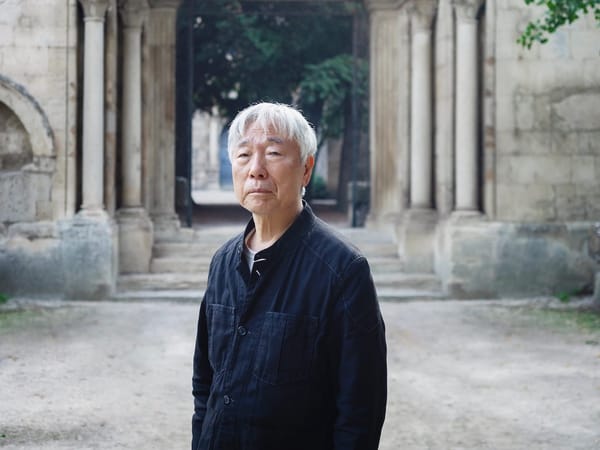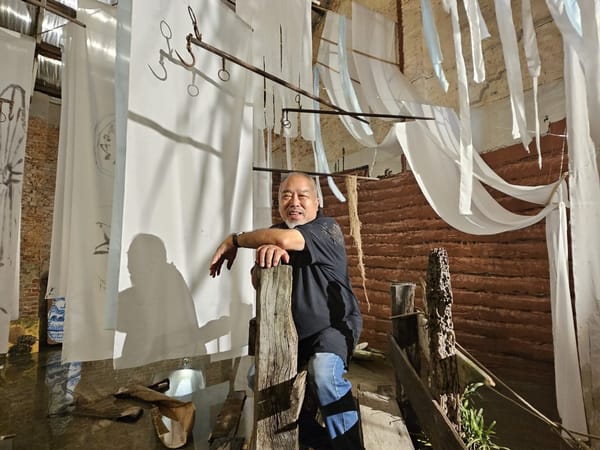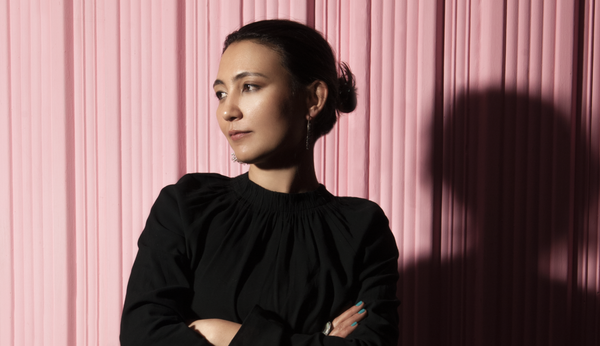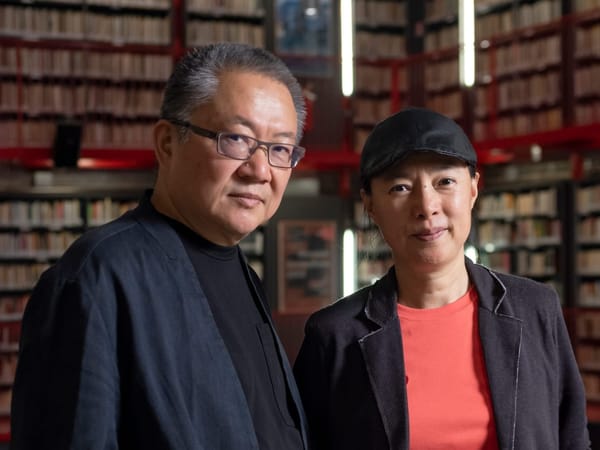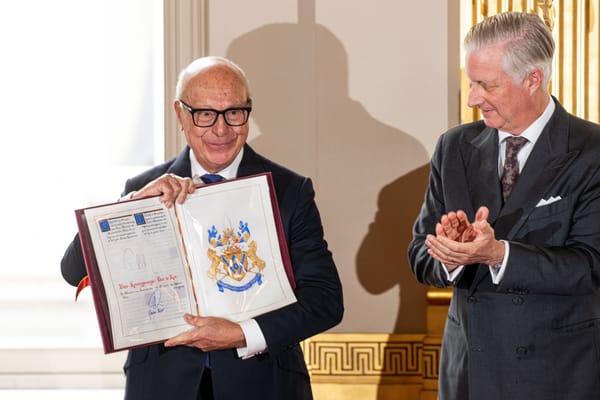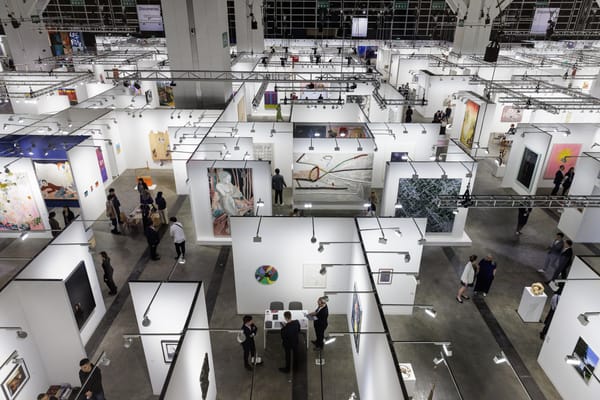News
Obituary: Shigeko Kubota (1937–2015)


Shigeko Kubota, a Japanese-born artist who worked in sculpture, video and installation and was married to Nam June Paik (1932–2006), died in New York on July 23. Her death was announced by the Nam June Paik Art Center in Yongin, Gyeonggi Province, South Korea, on Sunday.
The most iconic image of Shigeko Kubota is perhaps a black-and-white photograph of her performance Vagina Painting at the Perpetual Fluxus festival, held in New York on July 4, 1965. The image shows her squatting over a large white scroll of paper with a brush dipped in red paint protuding from between her legs (the brush was attached to a skirt she was wearing). The work, along with actions by her contemporaries such as Yoko Ono, Valie Export and Carolee Schneemann, is considered a feminist rebuttal to the “male-coded” modes of production, such as Jackson Pollock’s splatters of paint and Yves Klein’s “Anthropometry” canvases that were created with the impressions of nude female bodies. Yet, Vagina Painting was Kubota’s first and only performance work, as her long career of artistic production, beginning in early-1960s Japan and continued in New York, became centered around sculptures and then video and video installations. Her well-known work from 1976, Duchampiana: Nude Descending a Staircase, in the collection of the Museum of Modern Art, New York, features four small video screens, each playing Super-8 footage of a woman walking down a staircase, embedded into a wooden staircase maquette. It was a technologically and temporally expanded tribute to Duchamp’s short-lived 1912 foray into Cubist painting.
Shigeko Kubota was born in 1937 in Niigata, a city on the northwest coast of Honshu, Japan’s largest island. She studied sculpture at Tokyo University, where she graduated in 1960. A self-declared socialist and communist, she was a member of the radical National Federation of Student Self-Government Association. After university, she taught junior high school and made sculptures in her studio. She was introduced to the improvised musical performances of Group Ongaku through her aunt Kuni Chiya, who was a dancer. In 1962, she met John Cage and Yoko Ono in Japan when they were performing at Tokyo Bunka Hall. She had her first solo exhibition at Naiqua Gallery in Shinjuku, Tokyo, where she covered the floor with crumpled newspapers, created a mound of paper that she covered with a white sheet, and planted a big metal pipe sculpture in the middle of the space. “It’s a sculptural space in which you experience mountain climbing,” she said in a 2009 interview by art academic Miwako Tezuka.
Frustrated that no critics wrote about the Naiqua Gallery exhibition—although several had seen it—Kubota jumped at the chance to leave for New York, when an invitation came from George Maciunas for her to join Fluxus for a 1964 performance at Carnegie Hall. She and composer Mieko Shiomi, who founded Group Ongaku and would later become a Fluxus participant, went together, arriving on July 4, 1964. Kubota recalled, “George Maciunas was so pleased that he came to meet us at JFK airport. Then he took us to Fluxus’s office on Canal Street. It was fun. Ay-O lived next door. Takako Saitō was there, too. The address was 349 [sic, 359] Canal Street. I had my start there after meeting Fluxus, and I have hung around this area ever since.” Her first contribution to the group was the Flux Napkins (1965), which, with cut-out facial features, were used at Fluxus parties.
In New York, Kubota became a central figure in Fluxus, contributing to many of the group’s publications, and was named vice president of Fluxus by Maciunas for her help in running the group’s globe-spanning activities. There she got to know Nam June Paik, and eventually left her first husband, the Austrian composer David Behrman, to be with Paik whom she married in 1977. While working as an occasional reporter for the Japanese art magazine Bijutsu Techō (“Art Notebook”), she also continued to study art at New York University and the New School for Social Research in the mid-1960s, and then at the Art School of the Brooklyn Museum. Later, she became a video artist-in-residence at the Art Institute of Chicago in 1973, 1981–82 and 1984, and at the Kunstakademie in Düsseldörf in 1979. Kubota helped to coordinate the first annual Women’s Video Festival at the Kitchen in New York in 1972, and was curator of the city’s Anthology Film Archives from 1974 to 1982. She was the recipient of numerous grants and awards, including a 1987 Guggenheim Fellowship and 1998 Rockefeller Fellowship.
The launch of the battery-powered Sony Portapak video recording system in 1967 influenced her output greatly. She told Phong Bui in a 2007 Brooklyn Rail interview, “Film was chemical, but video was more organic. To me Portapack was like a new paint brush. It was certainly in the same spirit as Fluxus, ‘do it yourself.’” Her travel diary, Europe on 1/2 Inch a Day (1972), was created in response to her question “What happens if you travel with a Portapak instead of American Express through Europe?” and features her explorations of European subcultures (including Parisian sex clubs and a gay theater troupe), before ending with a visit to Duchamp’s grave in Rouen. Her video installation, Duchampiana: Video Chess (1968–1975), was inspired by her meeting Duchamp and his wife Teeny on a plane ride to Buffalo, New York, and her filming Duchamp and John Cage playing chess together on a sonically amplified board, in Toronto. She showed the video on a horizontally placed, tabletop-like monitor, on which she placed glass chess pieces. Another moving tribute, Duchamp’s Grave (1972–75) is a video-sculpture with 12 nine-inch monitors mounted in a vertical row on a free-standing plywood wall, with mirrors on the floor and ceiling that reflected the screens into an infinite column; it was first shown at the Kitchen in New York.
As with many of her best-known works, her 1973–75 video My Father was created as a eulogy. The video begins with a note explaining that her father died the day she bought a ticket home to Japan to see him, and includes scenes of her and her father watching television together while he is ill with cancer, as well as footage of herself mourning his death. She later made many tributes to her husband, such as Korean Grave (1993), inspired by their 1984 trip to Korea; Winter in Miami (2005), featuring footage taken by Paik’s nurse and recordings from that year of him playing piano compositions that he wrote when he was 13; and the figurative sculptures Nam June Paik I and II (2007), shown in her exhibition “My Life with Nam June Paik: Video Sculpture and Installation,” at New York’s Maya Stendhal Gallery.
However, despite her love for Paik, she also suffered from living in his artistic shadow, and spent a decade caring for him after his debilitating stroke in 1996 until his passing in 2006. Reflecting on her relationship with Nam June Paik, she told Miwako Tezuka: “We are very different, like water and oil. Even when I did my own stuff, people said, ‘She imitates Nam June.’ I found it infuriating. So I headed further in the direction of Duchamp. When Nam June went populist, I went for high art. . . with video, Nam June was experimental and dirty. Wires were sticking out from his early machine works. That’s why I went toward Duchamp. My work was very conceptual. I made boxes and put everything in them. Nam June encouraged me a lot.” In the same interview, she recalls that her work Duchampiana: Nude Descending a Staircase was well regarded at the Documenta 6 exhibition in 1977 and that curator Barbara London had purchased it for the Museum of Modern Art’s collection, as the museum’s first video-sculpture.
As news of Kubota’s death circulates, art-world figures have begun reflecting on her life and work. Jinsuk Suh, director of the Nam June Paik Art Center, told ArtAsiaPacific: “She should not just be remembered as a wife of Nam June Paik who supported him tremendously, but as a very powerful contemporary artist in her own right; as a talented, important member of Fluxus, as well as a collaborator of Paik. Many people know that even though she was in the background, she had an enormous influence on some of his ideas and his work.”
Do Hyung-teh, vice president of Gallery Hyundai, who was in her studio two weeks ago in New York to discuss a future show with her, commented to AAP: “As a student in New York in the mid-1990s, I would often visit Nam June Paik and Shigeko Kubota, particularly because my family’s gallery was supporting Nam June back then. I always remembered her as a great artist that wanted to be in her studio and work, but she also struggled with the belief that she had to support Nam June—who was in a wheelchair at that time—because she loved him very much. I remember being touched by how much she loved Nam June, even though she was an artist and she sacrificed a lot of herself for him. I will remember her as a very generous person.”
Tobias Berger, former chief curator of the Nam June Paik Art Center and current head of art at Hong Kong’s Jockey Club Central Police Station space, wrote: “I was fortunate enough to grow up in a home where one of our regular guests was Nam June Paik. He always said that his only true competition as an artist is his wife Shigeko Kubota. The work that was repeatedly talked about was a pissing robot. The idea that robots piss relieved me of all the future robot fears. It took over 30 years until I met Shigeko personally and finally saw the work in original. By then I was chief curator of the Nam June Paik Art Center in Korea and visited her in her studio in Soho. Seeing all her works there, as well as Nude Descending a Staircase, which was exhibited at MoMa at the same time, made me realize that Nam June was right. She was his only competition!”
Her death was also widely mourned on Facebook. Video artist Dara Birnbaum, well-known for her feminist critiques of women’s representation in popular culture in works such as Technology/Transformation: Wonder Woman (1979) wrote:
R.I.P. SHIGEKO Thank you for being such a strong and powerful woman in video… encouraging me and so many others. May your spirit be blessed. Always, Dara
